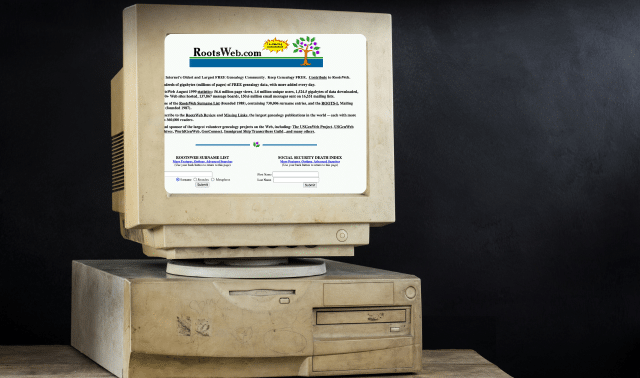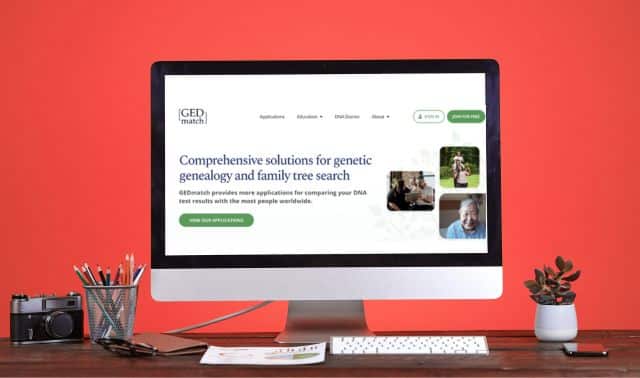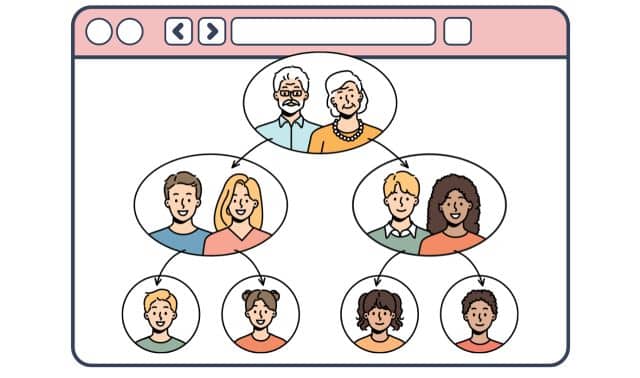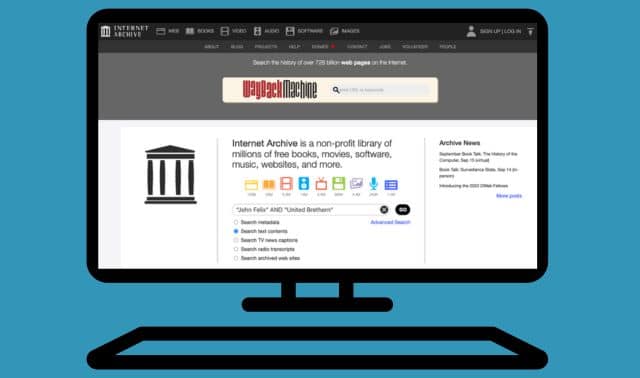Sign up for the Family Tree Newsletter! Plus, you’ll receive our 10 Essential Genealogy Research Forms PDF as a special thank you.
Get Your Free Genealogy Forms
"*" indicates required fields
Linda Lawson grew up thinking she had only a few relatives. Her grandfather’s family scattered when he was 8, after his father died and his mother abandoned five of the six children. Because Lawson’s grand-father rarely discussed his family, she knew little about her own heritage.
Years later, when Lawson visited a Roots Web West Virginia Web site, she was surprised to find a message referencing the surname Hinzman — the maiden name of the woman who’d left her children so many years earlier. Although the posting was two years old, Lawson contacted the author, who e-mailed her back and introduced her to many “Internet cousins” — those distant relatives who share an ancestor several generations back. Two cousins sent her the first photos she’d ever seen of her great-grand-mother. “When I opened that e-mail,” Lawson recalls, “I sat and cried.”
Lawson’s success is only one of thousands spawned by the Roots Web network <www.rootsweb.com>. Thanks to this genealogy giant, researchers have found their forebears, reconnected with living family members and met long-lost Internet cousins.
ADVERTISEMENT
Roots Web is the granddaddy of Internet genealogy, with a history that reaches back to the Dark Ages of Usenet and UNIX. It began as a small dream and evolved into a grand vision of unlimited access to free genealogical resources, assembled and put online by volunteers. In 2001, its ambitions outstripped its nonprofit resources, and Roots Web was purchased by MyFamily.com, the parent company of the popular subscription site Ancestry.com <Ancestry.com > (see page 30). But MyFamily.com promised that access to Roots Web would remain free forever.
The RootsWeb community now hosts more than 27,000 genealogy mailing lists and 132,000 message boards. Its World Connect project totals more than 285 million names, and more than a million entries have been submitted to the Roots Web Surname List. If information about your ancestor is online, it’s probably sitting in a database somewhere on this site.
In addition to its own offerings, Roots-Web plays host to some of the biggest and best genealogical sites on the Internet. These include Cyndi’s List <www.cyndislist.com>, USGen Web <www.usgenweb.org>, WorldGen Web <www.worldgenweb.org>, Cemetery Photos <www.rootsweb.com/˜cemphoto>, FreeBMD (births, marriages and deaths of England and Wales) <freebmd. rootsweb.com> and the Obituary Daily Times <www.rootsweb.com/˜obituary>.
ADVERTISEMENT
In fact, RootsWeb is so huge and sprawling that it’s easy to lose your way and not get the most out of this invaluable site. So use this road map to help your next visit to RootsWeb be all that it can be.
WorldConnect Project: Instant family trees
Imagine what it would be like if everyone in the genealogy community uploaded his or her GEDCOM files (the universal file format for family trees) to a central location, where other genealogists could then search them for free. Sound too good to be true? Well, it’s already happening at WorldConnect.
The project began in 1999, and in 2001, MyFamily.com combined it with Ancestry World Tree to create the largest pedigree database on the Web. Anyone can upload these GEDCOMs, and the submitter retains total control over the data, including the ability to remove individuals and revise and update data. Best yet, the whole shebang is searchable.
To contribute to the project, just create a GEDCOM file with your genealogy software. Then, using an online form, choose a user code for each tree you want to upload. During the submission process, you’ll be given a number of options. These include whether you want others to be able to download your file (limited to six generations), or whether you want to remove or clean all information about living people (defined as anyone born within the last 100 years who doesn’t have a death or burial date).
To search WorldConnect, you can enter just a surname, or narrow your search by entering a given name; places and dates of birth and death; or the name of the father, mother or spouse. Using the first method, I got 26,316 hits on the name Hendrickson. You also can check the Fuzzy Search box to use Soundex, which looks for spelling variations on a name. I changed my own search to look for John Hendrickson with a father named Aaron. All five hits were my John.
When you click on a name, you have the option of seeing all the names in that particular GEDCOM, or having the file displayed as a pedigree chart or Ahnentafel chart. Remember, none of this information has been checked by anyone other than the submitter, so use it only as a jumping-off point for your research. Unlike some GEDCOM sites, however, many WorldConnect files do contain source information, making it easier to verify and build on what you find.
Just like Ancestry World Tree, World-Connect offers Postem notes, the electronic equivalent of a sticky note. Use them to let other genealogists know you’re researching a particular family, note corrections to data, or place Web addresses for further reference.
Although researchers typically use World-Connect to search for a surname, try leaving the surname box empty and searching by location only. Using this type of search, you can find GEDCOMs containing neighbors, in-laws or allied families who lived in the same locale as your ancestors.
RootsWeb Surname List (RSL): Connecting with kin
Want to find an Internet cousin who’s already researched your family tree? Start here.
The RSL is a surname registry containing more than a million entries, submitted by more than 225,000 genealogists. And with hundreds of new entries added every day, your chances of connecting with another researcher through the RSL are excellent.
Search the RSL by entering a surname and selecting an exact or Soundex search option. The database will return a list of all of the matching surnames. If you get too many results, narrow the search by location.
The results are listed in a table format, with the following headings: Surname, From, To, Migration, Submitter and Comments. The From and To columns note the range of dates the researcher has established about that surname. A typical listing might read, “1850 to now.” The Migration column lists all known moves, and will look like this: “OH>IA>IN>MO>ID>OR.” If you click on the submitter’s name tag, you can access his or her e-mail address, as well as a list of every other surname that person has submitted to RSL.
If you have a common surname, try to define your search as narrowly as possible. And when you find a researcher you think is tackling the same branch of the family, take the time to look over the list of other surnames that person has submitted — it will give you clues to see if you have the right family. There’s no point in inundating a Smith researcher with e-mails if she’s not tracing your Smith branch.
To submit your own entries to the RSL, follow the directions on the site to create a name tag, which will then identify all of your submissions. Next, just fill out the form for each surname you’re submitting. Be sure to keep your name tag and password information: You’ll need it if you ever want to edit the data you’ve submitted or change your contact e-mail address.
Mailing Lists: You’ve got mail!
At last count, Roots Web hosted more than 27,000 genealogy mailing lists, on topics ranging from surnames and US counties to research techniques and ship passenger lists. Because everyone who subscribes to a mailing list has an interest in that topic, you have a good chance of connecting with other researchers or receiving research assistance on your subject.
Depending on the size and activity level of a list, you’ll receive anywhere from dozens of e-mails a day to one or two a month. When you first subscribe, you have the option to receive messages in mail mode or digest mode. Using mail mode, you’ll receive each message in a separate e-mail; using digest mode, you’ll receive several messages in one e-mail.
Once subscribed, you’ll get a confirmation e-mail, along with a welcome message that details any rules for posting to the list. This e-mail also will include instructions on how to unsubscribe, so tuck it away in a safe place.
RootsWeb mailing lists are like small communities. Each has its own personality. Some neighbors will help as much as possible; others will take part in group discussions only occasionally.
To find a list that suits your research needs, browse the index of list names, which is grouped by surname, US and international locations, and “other.” Surname lists are organized alphabetically, US lists by state, and international lists by country. Or you can search all the RootsWeb lists to find one that discusses your surname or the place where your ancestor lived (go to <lists.rootsweb. com/cgi-bin/f indlist.pl>).
Use surname lists to network with other people researching your name. Some surnames don’t have their own mailing lists, but many lists serve as umbrellas for surnames with a similar spelling. For example, the Wyckliffe list includes such variations as Wickliffe and Wycliffe.
Location lists are for people researching a specific locale. Some cover statewide interests; others focus on the county level. I belong to the Shelby County, Ind., mailing list, which is administered by Phyllis Fleming, the USGenWeb coordinator for the county. Whenever Fleming adds new data to the Web site, she automatically posts a notice to the mailing list. This keeps all of us on the list up-to-date on anything new coming online.
The “other” category contains a hodge-podge of lists. For instance, if your ancestor was a Friend, you might join the Quaker mailing list. Or if Great-great-grandpa participated in the California gold rush, you might find a priceless nugget on the Goldseekers list.
And let’s not forget the Roots-L list — the oldest one of its kind on the Internet. With thousands of subscribers, this list is the place to request help, ask about techniques, refer searchers to great new sites, ask about nick-names or share a software problem.
Because of Roots-L’s size, it has more rules than most lists, though its guiding principles are basic politeness and common sense. Instructions on subscribing are at <www.rootsweb.com/roots-l>. From the same page, follow the link to search the entire 16-plus years of archived messages.
If you’re new to mailing lists, you’ll be tempted to subscribe to a dozen right off the bat. But until you get a feel for the number of messages you’ll receive daily, you may want to subscribe to just a few. You also can search the archives (by year) of any mailing list you’re interested in without subscribing — you may find that someone has already posted the clues to your ancestry.
Roots-L State Resources: Really going places
<www.rootsweb.com/roots-l/usa.html>
Tucked away on a Roots Web back road is an often-overlooked treasure — all the odd bits and pieces that make up its US state resources. Were your ancestors Hawkeyes? Click on the Iowa link to read about Iowa Living History Farms, or study a guide to Iowa census schedules. Do you wonder what covered bridges your Kentucky ancestor might have traveled, or about Kentucky ghost towns? Click on the link for the Bluegrass State.
The State Resources pages contain links to just about every useful genealogical and historical resource available for each state. Plus, within each state’s pages is a box to search for surnames in that state’s RSL database.
This section also contains gems you’d be hard-pressed to find elsewhere, such as a transcription of the graves in the Cairo Cemetery, Tippecanoe County, Ind., or a history of Antoine Janis, a French fur trapper.
Although resources vary by state, you’ll usually find links to general resources, archives and libraries, military and cemetery resources, photographs, genealogical and historical societies, and vital records.
Searches: Finding your trees in the forest
Digging page by page through Roots Web’s archives, databases and mailing lists is a task best left to its powerful search engines. Start scouring the site’s databases by entering your ancestor’s first and last names into the search boxes at the top of the home page.
Next, explore the search options listed under Search Engines and Databases. Click Search Thingy or Meta Search to scan multiple Roots Web databases and files. For example, when I entered John Hendrickson into Meta Search, it found matches in 46 databases, including California Death Records, Kentucky Marriage Index and the Social Security Death Index.
One of my favorite search engines is the USGenWeb Archives Search, which looks at every text file ever posted to a USGenWeb page. A search for Dimmitt yielded 1,177 hits, spanning obituaries, marriage records and cemetery transcriptions.
Finally, browse the well-organized Database Index at <searches.rootsweb.com>. Here, you can search not only a number of US and international databases, but also the mailing-list archives.
Guides and newsletters: Staying informed
If you’re new to genealogy or delving into unfamiliar research waters, log on to Roots Web’s Guide to Tracing Family Trees. Authors Julia M. Case, Rhonda McClure and Myra Vanderpool Gormley have pooled their considerable genealogical knowledge to create more than 30 lessons on subjects ranging from genealogy fundamentals to the Social Security Death Index.
Each lesson contains an overview of the subject, defines terminology, offers research tips and tells you where to find records. The lesson on marriage records, for example, explains where to find marriage records or evidence of a marriage, and defines marriage-related terms such as bann and bond. You’ll also learn how other countries record marriages and where to search for those records.
Gormley also edits Roots Web Review, a weekly e-mail newsletter with information on new databases, home pages, reader tips and mailing lists. You can subscribe to the Review from the home page.
When Linda Lawson began climbing her family tree, she knew of only three cousins. Her chance reading of a Roots Web e-mail eventually led to an in-person reunion with 66 people related to her by blood or marriage. “I met strangers,” she says, “but left with family.”
Her success came through a Roots Web West Virginia site, but could just as easily have been the result of a mailing list, World-Connect file or message board. Where on RootsWeb will you find your family?
Compass Points
Find the path to your past with these other handy RootsWeb tools:
? Registry of Web Sites at RootsWeb
<www.rootsweb.com/˜websites>: Browse the tens of thousands of surname and regional Web sites hosted by RootsWeb.
?Soundex Converter
<resources.rootsweb.com/cgi-bin/ soundexconverter>: Calculate your surname’s Soundex code.
?US Social Security Death Index (SSDI)
ADVERTISEMENT




